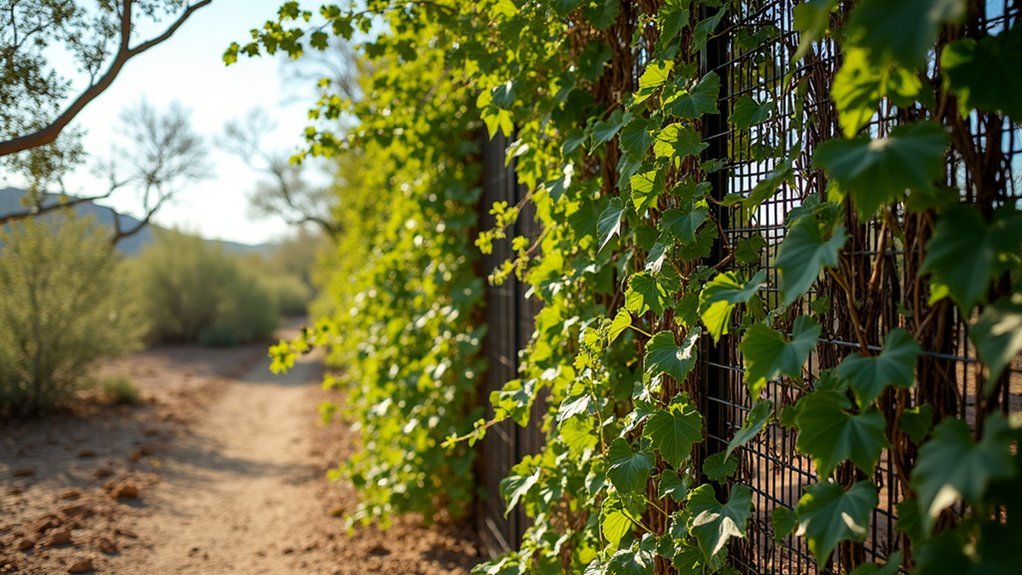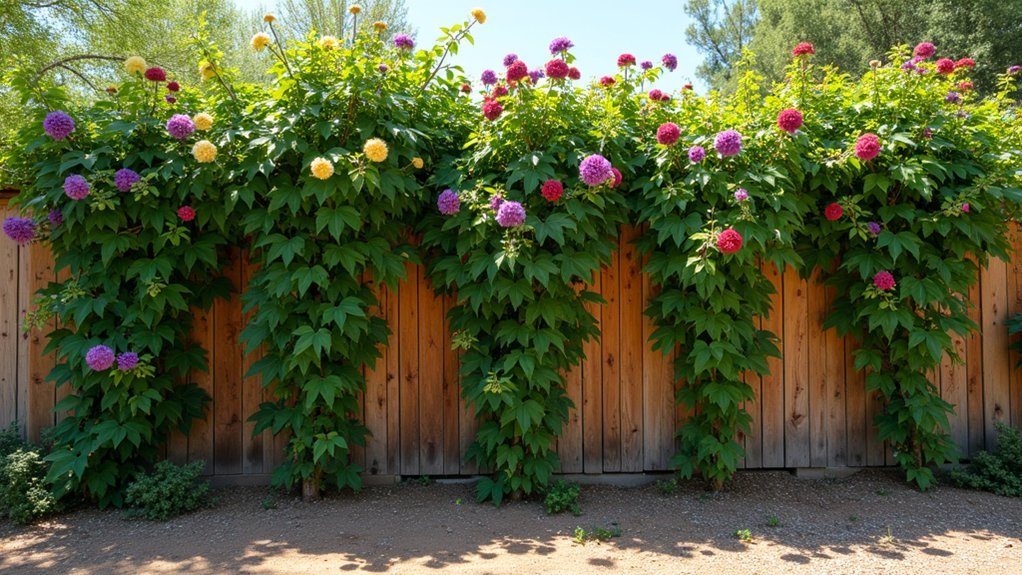For natural privacy barriers in dry conditions, choose drought-hardy vines like Wisteria, Bougainvillea, and Trumpet Vine. You’ll need sturdy support systems—rustic trellises, recycled material fences, wire grids, stone walls, or vertical posts—designed for these vigorous climbers. Each support system offers unique benefits, from moisture retention to heat resistance. Regular pruning maintains your desired shape and promotes flowering. The right combination of vine and structure creates a beautiful, water-efficient privacy solution for any landscape.
Rustic Trellises: Durable Supports for Heavy Drought-Tolerant Climbers

While creating a privacy screen with drought-hardy vines, you’ll need a sturdy foundation to support their substantial growth. Rustic trellises crafted from cedar or reclaimed wood provide ideal support for vigorous drought-tolerant climbers like Wisteria and Trumpet Vine.
When building these structures, aim for at least 6-8 feet of vertical space, allowing climbing vines to reach their full potential as natural privacy barriers. Incorporate cross-bracing or lattice designs to prevent sagging and enhance stability as plants expand and gain weight.
This additional reinforcement guarantees your trellis can withstand wind and the heft of mature vines.
Don’t forget regular maintenance checks for structural integrity and signs of rot. This simple upkeep extends your trellis’s lifespan while guaranteeing continued support for your drought-hardy privacy screen.
Recycled Material Fence Systems for Water-Conserving Vines
As homeowners seek sustainable solutions for garden privacy, recycled material fence systems have emerged as perfect partners for drought-hardy vines.
These eco-friendly support structures, crafted from reclaimed wood or plastic composites, greatly reduce your landscaping’s carbon footprint while providing sturdy frameworks for climbing plants.
You’ll appreciate how these systems retain moisture around vine roots, promoting water conservation in well-drained soils. Drought tolerant climbing vines like Bougainvillea and Wisteria thrive against these recycled backdrops, creating natural privacy barriers with minimal maintenance once established.
Beyond aesthetics, this combination offers practical benefits for arid landscapes. The fence-vine partnership contributes to soil stabilization, preventing erosion while the recycled materials create favorable microenvironments that help drought-hardy vines flourish even during water restrictions.
Heat-Resistant Wire Grid Structures for Arid Climate Privacy Screens

Beyond recycled fences, heat-resistant wire grid structures offer another exceptional solution for arid climate privacy needs.
These durable support systems create the perfect foundation for drought-tolerant climbing plants, transforming bare spaces into lush vertical walls despite challenging conditions.
You’ll find these grids particularly valuable as they maximize full sun exposure—essential for most fast-growing vine varieties that thrive in arid climates.
By adjusting the wire spacing, you can accommodate various growth rates and soil types without risking overcrowding.
Galvanized or coated materials guarantee your structure withstands intense heat while resisting rust and degradation.
This longevity makes wire grids an excellent investment for establishing privacy barriers that improve with time.
Consider incorporating diverse vine species on a single grid to create a visually dynamic screen that remains robust throughout the seasons.
Stone Wall Integration: Combining Masonry With Xeric Climbing Plants
Stone walls transform dramatically when paired with drought-hardy climbing plants, creating privacy screens that blend structural strength with natural beauty.
You’ll find xeric climbing plants like Bougainvillea and Wisteria particularly effective, as they thrive in full sun and well-drained soil conditions typical of masonry settings.
Your stone walls provide ideal support for climbing vines, allowing them to grow vertically while softening harsh hardscapes with lush foliage and vibrant blooms.
Stone walls and climbing vines create perfect partnerships, blending strength with natural softness in a vertical garden display.
The combination creates efficient privacy barriers while enhancing your landscape’s aesthetic appeal.
Remember that regular pruning is essential to maintain the vines’ shape and encourage prolific flowering.
Vertical Post Systems: Maximizing Growth Patterns of Drought-Hardy Vines

Vertical post systems offer exceptional versatility for drought-hardy vine privacy screens when stone walls aren’t practical for your landscape.
You’ll find these sturdy support structures provide the perfect foundation for climbing plants to establish natural privacy barriers efficiently.
Consider proper spacing between posts based on your chosen vine’s growth rate and mature size. Fast-growing varieties need wider spacing, while slower growers benefit from closer positioning.
Incorporate trellises or arbors to enhance airflow and sunlight exposure, encouraging healthier growth and abundant flowering.
Don’t neglect regular pruning to control direction and prevent overgrowth. Training vines along your vertical supports during early growth stages guarantees they’ll develop in your desired pattern.
With thoughtful design and maintenance, your drought-hardy vines will transform simple posts into a lush, living privacy screen.
Frequently Asked Questions
What Is the Fastest Growing Vine for Privacy?
For privacy, Virginia Creeper is your fastest option, growing up to 50 feet quickly. Cat’s Claw Vine is also impressive, adding up to 10 feet per season with its lush, screening foliage.
What Vine Is Drought Tolerant?
You’ll find numerous drought-tolerant vines including Arizona Grape Ivy, Bougainvillea, Cat’s Claw Vine, Honeysuckle, and Trumpet Vine. They all require minimal watering while still providing beautiful coverage for your outdoor spaces.
What Are the Best Self-Clinging Vines?
The best self-clinging vines include English Ivy with its aerial roots, Virginia Creeper with its adhesive pads, Creeping Fig for shade areas, Crossvine with its beautiful blooms, and Arizona Grape Ivy for versatile coverage.
What Vine Grows Out of Control?
You’ll find Cat’s Claw Vine, Arizona Grape Ivy, Virginia Creeper, Trumpet Vine, and Bougainvillea commonly grow out of control. Without regular pruning, they’ll quickly overtake structures and neighboring plants in your garden.
In Summary
You’ve discovered how drought-hardy vines can transform your outdoor spaces while conserving water. Whether you’re using rustic trellises, recycled materials, wire grids, stone walls, or vertical posts, these support systems maximize your privacy plants’ potential. By pairing the right structure with appropriate xeric climbers, you’ll create beautiful, sustainable barriers that thrive in hot, dry conditions without excessive watering. It’s an eco-friendly solution that keeps your space both private and green.





Leave a Reply